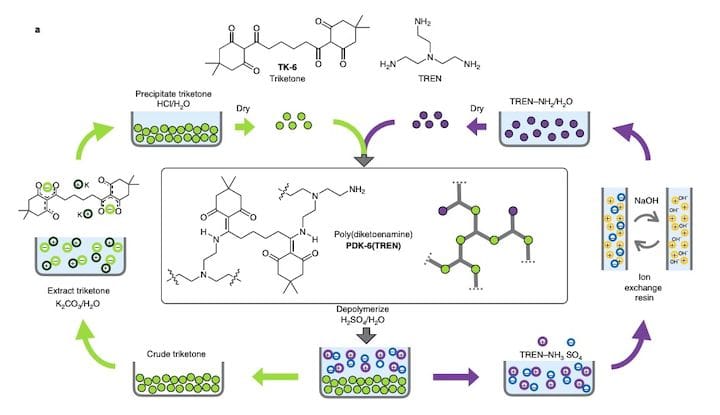![Chemical sequence for a recyclable thermoset [Source: Nature]](https://fabbaloo.com/wp-content/uploads/2020/05/image-asset_img_5eb0929211758.jpg)
Researchers have developed a way to recycle thermoset plastic.
In the world of 3D printing, there are two kinds of plastics: thermoplastic and thermoset.
Thermoplastics have the unusual property of being able to be repeatedly softened and hardened through temperature; this is how all FFF extrusion-style 3D printers work. A filament is softened and pushed through a precision nozzle. Once it’s removed from the heat, the cooling causes the thermoplastic material to solidify. Hopefully, it’s in the correct shape.
That object can then be reheated to again soften the material and it can be reused for other purposes.
Meanwhile, thermosets are quite different. While they are typically liquid, a chemical reaction, sometimes an application of energy from a laser, can cause them to solidify. But the difference is that the resulting object cannot be recycled back into original material for re-printing. Once made, it’s done.
Most resin-based 3D printer systems use thermoset materials. This is why it’s possible to 3D print high-temperature-resistant objects with SLA systems, for example: no extreme heat was used to create them, as would be required for high-temperature thermoset materials.
This means that by definition all scraps from resin 3D printing are plastic waste. Removed support structures, failed prints: all are essentially unrecoverable waste, as any known techniques are quite costly. That’s bad news in today’s world of omnipresent microplastics in our environment.
But things may change based on some pioneering research taking place at the Lawrence Berkeley National Laboratory in California, where researchers seem to have discovered a way to easily recover thermosets, or at least one specific mixture they’ve devised. They call this a “closed loop polymer cycle”, something thermoplastics use all the time.
Closed Loop Polymers
They explain the process:
“Here, we show that next-generation plastics—polymerized using dynamic covalent diketoenamine bonds—allow the recovery of monomers from common additives, even in mixed waste streams. Poly(diketoenamine)s ‘click’ together from a wide variety of triketones and aromatic or aliphatic amines, yielding only water as a by-product. Recovered monomers can be re-manufactured into the same polymer formulation, without loss of performance, as well as other polymer formulations with differentiated properties. The ease with which poly(diketoenamine)s can be manufactured, used, recycled and re-used—without losing value—points to new directions in designing sustainable polymers with minimal environmental impact.”
Basically they have designed a polymer that bonds together with chemicals that break down (or depolymerize) when exposed to a strong aqueous acid for at least twelve hours. The resulting monomers can be “remanufactured” into resin that can be again used as a thermoset material.
At top you can see a chart of the chemical sequence required. It’s not particularly straightforward, but is said to be industrially scalable and financially feasible.
Recyclable Photopolymers?
The catch here is that these research resins are not photopolymer resins, which are the specific type of material used in SLA and similar 3D printing processes. These resins are specifically designed to solidify (polymerize) when exposed to certain frequencies of light, typically matching the laser light’s frequency in a 3D printer.
I’m no chemist, but I’m wondering if it is theoretically possible to devise a photopolymer version of this recyclable thermoset resin? If this could be achieved, then we could see a new form of recycling in 3D printing for resin equipment.
Perhaps this is chemically impossible, but if it is possible, it might be an interesting development. While the number of individual resin 3D printers is today relatively small, it’s quite possible we may see the emergence of vast factories full of resin 3D printing equipment in future years. Such operations would generate a considerable amount of waste unless we had a thermoset recycling program based on this research.
Via Nature











A research thesis details the incredibly complex world of volumetric 3D printing. We review the highlights.